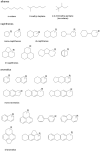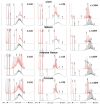Update of the risk assessment of mineral oil hydrocarbons in food
- PMID: 37711880
- PMCID: PMC10498375
- DOI: 10.2903/j.efsa.2023.8215
Update of the risk assessment of mineral oil hydrocarbons in food
Abstract
Mineral oil hydrocarbons (MOH) are composed of saturated hydrocarbons (MOSH) and aromatic hydrocarbons (MOAH). Due to the complexity of the MOH composition, their complete chemical characterisation is not possible. MOSH accumulation is observed in various tissues, with species-specific differences. Formation of liver epithelioid lipogranulomas and inflammation, as well as increased liver and spleen weights, are observed in Fischer 344 (F344) rats, but not in Sprague-Dawley (SD) rats. These effects are related to specific accumulation of wax components in the liver of F344 rats, which is not observed in SD rats or humans. The CONTAM Panel concluded that F344 rats are not an appropriate model for effects of MOSH with wax components. A NOAEL of 236 mg/kg body weight (bw) per day, corresponding to the highest tested dose in F344 rats of a white mineral oil product virtually free of wax components, was selected as relevant reference point (RP). The highest dietary exposure to MOSH was estimated for the young population, with lower bound-upper bound (LB-UB) means and 95th percentiles of 0.085-0.126 and 0.157-0.212 mg/kg bw per day, respectively. Considering a margin of exposure approach, the Panel concluded that the present dietary exposure to MOSH does not raise concern for human health for all age classes. Genotoxicity and carcinogenicity are associated with MOAH with three or more aromatic rings. For this subfraction, a surrogate RP of 0.49 mg/kg bw per day, calculated from data on eight polycyclic aromatic hydrocarbons, was considered. The highest dietary exposure to MOAH was also in the young population, with LB-UB mean and 95th percentile estimations of 0.003-0.031 and 0.011-0.059 mg/kg bw per day, respectively. Based on two scenarios on three or more ring MOAH contents in the diet and lacking toxicological information on effects of 1 and 2 ring MOAH, a possible concern for human health was raised.
Keywords: MOAH; MOSH; Mineral oil hydrocarbons (MOH); alkanes; aromatic hydrocarbons; human dietary exposure; toxicity.
© 2023 European Food Safety Authority. EFSA Journal published by Wiley‐VCH GmbH on behalf of European Food Safety Authority.
Figures



(a): Samples reported by European food associations without specifying the sampling country.


















Similar articles
-
Assessment of hazards and risks associated with dietary exposure to mineral oil for the Belgian population.Food Chem Toxicol. 2021 Mar;149:112034. doi: 10.1016/j.fct.2021.112034. Epub 2021 Jan 30. Food Chem Toxicol. 2021. PMID: 33529678
-
Survey of mineral oil hydrocarbons in Chinese commercial complementary foods for infants and young children.Food Addit Contam Part A Chem Anal Control Expo Risk Assess. 2021 Sep;38(9):1441-1455. doi: 10.1080/19440049.2021.1926548. Epub 2021 Jun 2. Food Addit Contam Part A Chem Anal Control Expo Risk Assess. 2021. PMID: 34077340
-
Screening for mineral oil saturated and aromatic hydrocarbons in paper and cardboard directly by planar solid phase extraction and by its coupling to gas chromatography.J Chromatogr A. 2019 Mar 15;1588:48-57. doi: 10.1016/j.chroma.2018.12.043. Epub 2018 Dec 21. J Chromatogr A. 2019. PMID: 30591246
-
Evaluating the risk to humans from mineral oils in foods: Current state of the evidence.Food Chem Toxicol. 2020 Feb;136:110966. doi: 10.1016/j.fct.2019.110966. Epub 2019 Nov 18. Food Chem Toxicol. 2020. PMID: 31751646 Review.
-
Analytical Methods for the Determination of Mineral Oil Saturated Hydrocarbons (MOSH) and Mineral Oil Aromatic Hydrocarbons (MOAH)-A Short Review.Anal Chem Insights. 2018 Jun 4;13:1177390118777757. doi: 10.1177/1177390118777757. eCollection 2018. Anal Chem Insights. 2018. PMID: 29887729 Free PMC article. Review.
Cited by
-
Peer review of the pesticide risk assessment of the active substance paraffin oil (CAS 8042-47-5, chain lengths C17-C31).EFSA J. 2024 Jul 23;22(7):e8913. doi: 10.2903/j.efsa.2024.8913. eCollection 2024 Jul. EFSA J. 2024. PMID: 39045513 Free PMC article. Review.
-
A Study on Mineral Oil Hydrocarbons (MOH) Contamination in Pig Diets and Its Transfer to Back Fat and Loin Tissues.Animals (Basel). 2024 May 13;14(10):1450. doi: 10.3390/ani14101450. Animals (Basel). 2024. PMID: 38791667 Free PMC article.
-
Investigation of potential migratables from paper and board food contact materials.Front Chem. 2023 Nov 30;11:1322811. doi: 10.3389/fchem.2023.1322811. eCollection 2023. Front Chem. 2023. PMID: 38099191 Free PMC article.
References
-
- Adenuga D, Goyak K and Lewis R, 2017. Evaluating the MoA/human relevance framework for F‐344 rat liver epithelioid granulomas with mineral oil hydrocarbons. Critical Reviews in Toxicology, 47, 754–770. - PubMed
-
- Agarwal R, Shukla Y, Kumar S and Mehrotra NK, 1988. Evaluation of carcinogenic effect of jute batching oil (JBO‐P) fractions following topical application to mouse skin. Archives of Toxicology, 62, 406–410. - PubMed
-
- ANSES (Agence nationale de sécurité sanitaire, de l'alimentation, de l'environnement et du travail) , 2017. Avis de l'Anses relatif à la migration des composés d'huiles minérales dans les denrées alimentaires à partir des emballages en papiers et cartons recycles. Available online: https://www.anses.fr/fr/system/files/ESPA2015SA0070.pdf
-
- API (American Petroleum Institute) , 2003. Robust Summary Information on aromatic extracts. Available online: https://www.petroleumhpv.org/-/media/PetroleumHPV/Documents/2012_may21_A...
LinkOut - more resources
Full Text Sources

